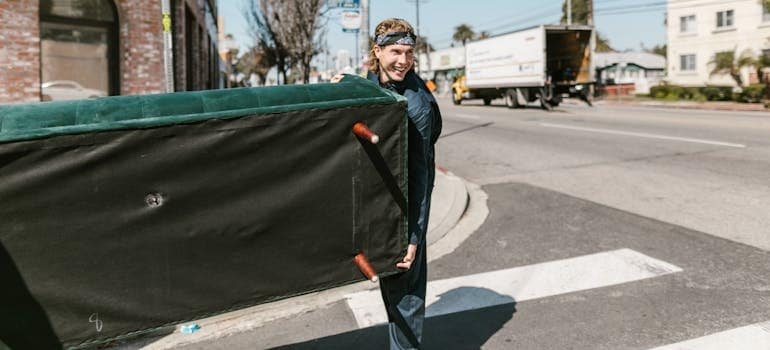The image of a company means everything today. We live in a time where people make decisions based heavily on a company’s online presence and reputation on social media. Customers are quick to move on if they don’t like what they see. As a small moving business, you need a long-term plan of action to build and maintain trust with potential clients. This is why you need a strong brand development strategy for movers. It helps establish a consistent image and reputation, ensuring your company stands out in a competitive market and appeals to customers who value reliability and professionalism.
Brand development strategy for movers defined
Branding is all about building and strengthening your moving company’s identity. We at Movers Development explore the brand development strategy through three stages:
- Aligning your brand with your business objectives: Your brand should reflect what your moving company stands for and what makes you unique.
- Acquiring the right tools to communicate your brand: This includes creating a logo, tagline, website, and other assets that make your brand recognizable.
- Strengthening your brand: This final stage focuses on reinforcing your brand’s presence through consistent messaging and customer engagement.

10-step brand development strategy for movers
To make it easier, we’ve broken down the entire process into ten practical steps, which will guide you through building a brand that lasts. Here are the things you should do:
- Visualize your company’s future
- Consider your business strategy
- Identify your target customers
- Focus on your brand positioning
- Develop your messaging strategy
- Choose your name, logo, and tagline
- Create your content
- Build your website
- Develop your marketing toolkit
- Make, monitor, and maintain your brand
Visualize your company’s future
To build a successful brand, you need to have a clear vision of your company’s future. Setting specific objectives will help guide your business toward growth. One effective way to do this is by establishing SMART goals—goals that are Specific, Measurable, Achievable, Relevant, and Time-bound.
For example, instead of a vague goal like “grow the business,” a SMART goal would be: “Increase local moves by 20% within the next 12 months by targeting young families through digital marketing campaigns.” This goal is clear, measurable, and tied to a specific timeline.
By setting SMART goals, you can visualize where your company is headed, track your progress, and adjust your brand development strategy for movers to ensure steady growth.

Consider your business strategy
What type of services do you want to provide? Are you focused on local moves, or do you aim to expand interstate or even internationally? The goals you set for your business will shape your brand development. Market positioning is very important. Here are some choices you can make:
- Eco-friendly: Emphasizing sustainable practices, such as using eco-friendly packaging materials and fuel-efficient trucks.
- Luxury: Offering premium, high-touch moving services with added conveniences like packing, storage, and white-glove service.
- Budget-friendly: Focusing on affordable, reliable services for cost-conscious customers.
Identify your target customers
Simply saying “everyone” is a mistake—successful companies focus on well-defined client groups. The more specific your focus, the faster your business can grow.
So, how do you define your ideal clients? This is where customer personas and market research will be necessary. Research goes beyond assuming that “everyone interested in moving” is your audience. Instead, you need to analyze where people are moving, their demographics (age, family status, etc.), and their specific needs.
By developing customer personas based on real data, you will gain insight into what drives your customers, what they prioritize, and how they view your brand. This will help you find the right ways to advertise your moving business and meet your customers’ needs.
Focus on your brand positioning
Once you’ve done your research, it’s time to determine your brand’s place in the moving industry, also known as market positioning. The key question is: how does your moving company stand out, and why should clients choose you over the competition?
To answer this, you need a strong and clear positioning statement. This statement, usually 3-5 sentences, should capture what your brand represents and why it matters to your customers. It’s important to strike the right balance—being both ambitious and realistic. This shows that your company is progressive while staying grounded in its capabilities.
Here’s a checklist to help define your brand positioning:
- What unique services do you offer that competitors don’t?
- What pain points do your customers have, and how does your company solve them?
- What values are central to your company’s mission?
- How do you want customers to feel when they use your services?
- What long-term goals does your company have for growth and customer relationships?
For example, a moving company that focuses on eco-friendly practices might create a positioning statement like this: “At our company, we provide environmentally responsible moving services, ensuring a smooth, worry-free experience while reducing our carbon footprint. Our mission is to make moving easier and greener, with a commitment to sustainability that benefits our customers and the planet.”

Develop your messaging strategy
Once you’ve defined your brand positioning, the next step is converting it into tailored messages for your target audience. In the moving industry, your target audience typically includes:
- Potential clients
- Potential business partners
- Referral sources
- Potential employees
Although your core brand message stays the same, each of these groups cares about different aspects of your business. This is why it’s important to customize your messaging to highlight the most relevant points for each audience. For example, you wouldn’t pitch the benefits of partnering with your company to potential clients—each message needs to hit the right note for its specific audience.
Here’s how you can tailor your messaging:
- Potential clients: Highlight reliability, customer satisfaction, and ease of the moving process. For example: “At our company, we ensure a stress-free moving experience by handling every detail with care. Our team is dedicated to making your move smooth and efficient, with a focus on safety and timely delivery.”
- Potential business partners: Emphasize long-term growth and mutual benefits. For example: “Partnering with our company means joining a team that values collaboration, trust, and shared success. We offer scalable solutions that can enhance your business while delivering exceptional service to our shared customers.”
Choose your name, logo, and tagline
While a name change is usually unnecessary, it may be worth considering if your company is new, merging, or if your current name no longer reflects the services you offer. Even if you keep your company name, updating your logo and tagline can help better align with your brand positioning.
Keep in mind that while these elements are important, they aren’t your brand itself. Instead, they serve as symbols that communicate your brand to clients. Your brand is ultimately represented by the quality and reliability of the moving services you provide.
Here are a few tips for choosing effective names, logos, and taglines tailored to moving companies:
- Name: Opt for something easy to remember, and that reflects your services. For example, incorporating words like “relocation,” “moving,” or “transport” helps communicate your expertise immediately.
- Logo: Keep it simple and professional. A clean design with a moving-related symbol, such as a truck or house, can effectively signal your services at a glance.
- Tagline: Craft a tagline that speaks to your key selling point. For example, “Moving made easy” or “On time, every time” can reflect reliability and customer satisfaction, key traits in the moving industry.
Consistency is a very important brand development strategy for movers—your name, logo, and tagline should all align with your brand’s core message. This creates a cohesive identity that customers will easily recognize and trust.
Create your content
Effective content builds both trust and authority—two essential elements of a strong brand development strategy for movers. You can position your company as an expert in the moving industry by providing helpful resources, such as packing tips, moving checklists, and customer testimonials. For example, a detailed blog post on “How to Safely Pack Fragile Items” helps customers and boosts your search engine visibility, driving more traffic to your website.
Content marketing strengthens your brand’s reputation and increases visibility at the same time. By consistently sharing useful information, you become the go-to resource for clients seeking relocation services, building long-term trust. Plus, utilizing SEO for moving companies will improve your ranking in search results, making it easier for potential customers to find your business.

Build your website
Your official website is the central hub where potential clients learn about your moving company—what you do, how you do it, and why they should choose you. While your website alone won’t guarantee success, it encourages visitors to act, whether reaching out for more information or requesting a quote.
Your website is also where valuable content for SEO efforts lives, helping potential clients and partners find your business more easily. You need to analyze your website and design it well. It is one of the most important elements of your brand development strategy for movers as it positions your company as knowledgeable and approachable.
To ensure your website serves its purpose, it’s important to follow these user experience best practices:
In the last quarter of 2023, mobile phones comprised 58.67% of global website traffic.
- Mobile responsiveness: In the last quarter of 2023, mobile phones made up 58.67% of global website traffic. Therefore, you need to make sure your site is easy to navigate on all devices.
- Easy access to quotes: Include clear call-to-action buttons that allow users to get a moving estimate or request more information quickly.
- Interactive features: Tools like online moving calculators or scheduling options can engage visitors and make their experience smoother, helping to convert them into customers.
There are two types of professional websites that moving companies can benefit from:
- Branding website: This site tells your story, conveying who you are, what services you offer, and who your clients are. It focuses on communicating your brand message.
- High-performance website: In addition to telling your brand’s story, this site is designed to generate leads and nurture potential clients through features like contact forms, live chat, and downloadable resources.

Develop your marketing toolkit
A marketing toolkit includes creating essential materials that help promote your moving company. One useful tool is a moving quote calculator that attracts customers. It provides potential customers with quick answers to the common question: “How much will it cost me to move?” You can attract more clients and increase engagement by offering practical solutions like this.
Your marketing toolkit should include visual content, such as photos and videos. Video content, in particular, can be highly effective in showcasing your brand and services. Consider creating videos that focus on:
- Company overviews: Highlight your team, services, and what sets you apart from other movers.
- Case studies: Share real-life examples of successful moves, giving potential customers confidence in your abilities.
- Behind-the-scenes or “Meet the Team”: These videos personalize your company, making it more relatable and trustworthy.
Social media plays a vital role in your marketing efforts as well. Platforms like Facebook, Instagram, and YouTube allow you to share these videos and other content, increasing your visibility. Posting regular updates, sharing customer testimonials, and offering moving tips can build a stronger connection with your audience.
Additionally, key services landing pages on your website are beneficial. These pages, when well-designed and SEO-optimized, help convert leads and reinforce your brand identity. By integrating photos, videos, and tools like moving calculators, you create a comprehensive toolkit that supports both business development and brand growth.
Make, monitor, and maintain your brand
These are the 3 M’s of brand development: make, monitor, and maintain. This final step in your brand development strategy is one of the most important. A winning strategy doesn’t do much good if it’s never fully implemented. Surprisingly, many businesses develop a solid plan but fail to put it into action due to everyday demands.
Once your brand development strategy is in place, you need to monitor both its execution and the results it generates. Regularly checking progress ensures you’re on track and helps identify areas for improvement. Key metrics to monitor include:
- Website traffic: Are more visitors finding your site? How long are they staying?
- Lead generation: How many new inquiries or quote requests have been made since implementing the strategy?
- Customer feedback: Are customers mentioning your brand’s strengths? Are there areas for improvement?
- Conversion rates: How many visitors are converting into clients?
- Employee applications: Are you attracting the right talent to help grow your business?
- Partnership opportunities: Have new collaborations or business opportunities emerged?
Once you’ve gathered this data, use it to maintain and improve your brand development strategy for movers. If certain areas aren’t yielding the expected results, make adjustments. For example, if website traffic is up but conversions are low, you might need to refine your landing pages or call-to-action buttons.

Grow your business with a strong brand development strategy for movers
A strong brand development strategy for movers helps you stand out, build trust, and grow sustainably. You can strengthen your brand over time by aligning your strategy with business goals, creating engaging content, and monitoring your efforts. Now is the time to act. Start applying the steps discussed and build a brand that reflects your company’s values. If you need help, reach out for a consultation. Develop a brand that drives long-term success.






